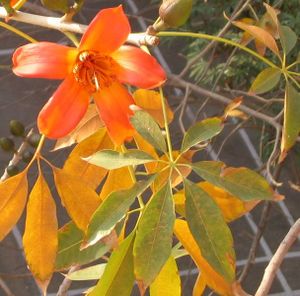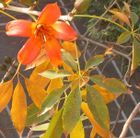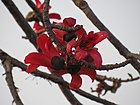Note: This is a project under development. The articles on this wiki are just being initiated and broadly incomplete. You can Help creating new pages.
Difference between revisions of "Bombax ceiba - Kutasalmali"
(→Uses) |
(→References) |
||
| Line 91: | Line 91: | ||
<ref name="How to plant/cultivate">[https://pfaf.org/user/Plant.aspx?LatinName=Bombax+ceiba Cultivation Details]</ref> | <ref name="How to plant/cultivate">[https://pfaf.org/user/Plant.aspx?LatinName=Bombax+ceiba Cultivation Details]</ref> | ||
<ref name="Kind of soil needed">[https://pfaf.org/user/Plant.aspx?LatinName=Bombax+ceiba Kind of soil needed]</ref> | <ref name="Kind of soil needed">[https://pfaf.org/user/Plant.aspx?LatinName=Bombax+ceiba Kind of soil needed]</ref> | ||
| + | |||
| + | <ref name="Uses">Karnataka Medicinal Plants Volume - 2 by Dr.M. R. Gurudeva, Page No. 234</ref> | ||
</references> | </references> | ||
Revision as of 11:21, 8 October 2021
Bombax ceiba is a medicinal tree and is also referred as silent doctor. It is found in India, Malaysia, Sri lanka, Hong kong, Australia and Africa. Every part of this tree is used to treat various ailments.
Contents
- 1 Uses
- 2 Parts Used
- 3 Chemical Composition
- 4 Common names
- 5 Properties
- 6 Habit
- 7 Identification
- 8 List of Ayurvedic medicine in which the herb is used
- 9 Where to get the saplings
- 10 Mode of Propagation
- 11 How to plant/cultivate
- 12 Season to grow
- 13 Required Ecosystem/Climate
- 14 Kind of soil needed
- 15 Commonly seen growing in areas
- 16 Photo Gallery
- 17 References
- 18 External Links
Uses
Semen problems, Leucorrhoea, Over bleeding in menstruation, Acne, Skin blemish, Pigmentation, Wounds, Cold, Sore throats, Cough[1]
Parts Used
Chemical Composition
Stem and root bark contains lupeol, β-sitosterol, naphthoquinone compound, phenolic substances, a lactone, 4 sesquiterpenes. Root yields triacontanol, β- sitosterol.[2]
Common names
| Language | Common name |
|---|---|
| Kannada | Marahatti, Kempu booruga |
| Hindi | Shalmali |
| Malayalam | Unnamurika |
| Tamil | Sittan, Sanmali |
| Telugu | Buruga |
| Marathi | NA |
| Gujarathi | NA |
| Punjabi | NA |
| Kashmiri | NA |
| Sanskrit | Shalmali, Semul, Simul |
| English | Silk Cotton Tree, Kapok Tree |
Properties
Reference: Dravya - Substance, Rasa - Taste, Guna - Qualities, Veerya - Potency, Vipaka - Post-digesion effect, Karma - Pharmacological activity, Prabhava - Therepeutics.
Dravya
Rasa
Kashaya (Astringent)
Guna
Laghu (Light), Snigda (haevy)
Veerya
Sheeta (cold)
Vipaka
Madhura (Sweet)
Karma
Prabhava
Habit
Identification
Leaf
| Kind | Shape | Feature |
|---|---|---|
| Simple | Digitate | Leaf Shape is Oblong-lanceolate or elliptic and Leaf Arrangement is Alternate -spiral |
Flower
| Type | Size | Color and composition | Stamen | More information |
|---|---|---|---|---|
| Unisexual | 2-4cm long | Yellow | 5-20 | Solitary, paired or clustered; blood red. Flowering from April-March |
Fruit
| Type | Size | Mass | Appearance | Seeds | More information |
|---|---|---|---|---|---|
| Oblong capsule | 7–10 mm | Fruiting April onwards | A loculicidal, oblong capsule, 5-valved | Many | {{{6}}} |
Other features
List of Ayurvedic medicine in which the herb is used
Where to get the saplings
Mode of Propagation
How to plant/cultivate
Seed - sown fresh, without pre-treatment, they have a high germination rate. Some reports suggest germination rates can be improved by pre-soaking the seeds for 12 hours prior to sowing [5]
Season to grow
Summer
Required Ecosystem/Climate
It cannot grow in the shade. It prefers dry or moist soil.
Kind of soil needed
Light (sandy), medium (loamy) and heavy (clay) soils and prefers well-drained soil. Suitable pH: neutral and basic (alkaline) soils and can grow in very alkaline soils.[6]
Commonly seen growing in areas
Hot region, At elevations below 1,400 metres, Humid lowland deciduous forests, Dry river valleys.
Photo Gallery
References
- ↑ Karnataka Medicinal Plants Volume - 2 by Dr.M. R. Gurudeva, Page No. 234
- ↑ Chemical constituents
- ↑ Morphology
- ↑ Ayurvedic preparations
- ↑ Cultivation Details
- ↑ Kind of soil needed
External Links
- Ayurvedic Herbs known to be helpful to treat Semen problems
- Ayurvedic Herbs known to be helpful to treat Leucorrhoea
- Ayurvedic Herbs known to be helpful to treat Over bleeding in menstruation
- Ayurvedic Herbs known to be helpful to treat Acne
- Ayurvedic Herbs known to be helpful to treat Skin blemish
- Ayurvedic Herbs known to be helpful to treat Pigmentation
- Ayurvedic Herbs known to be helpful to treat Wounds
- Ayurvedic Herbs known to be helpful to treat Cold
- Ayurvedic Herbs known to be helpful to treat Sore throats
- Ayurvedic Herbs known to be helpful to treat Cough
- Herbs with Flowers used in medicine
- Herbs with Leaves used in medicine
- Herbs with common name in Kannada
- Herbs with common name in Hindi
- Herbs with common name in Malayalam
- Herbs with common name in Tamil
- Herbs with common name in Telugu
- Herbs with common name in Sanskrit
- Herbs with common name in English
- Habit - Deciduous tree
- Index of Plants which can be propagated by Seeds
- Index of Plants which can be propagated by Cuttings
- Herbs that are commonly seen in the region of Hot region
- Herbs that are commonly seen in the region of At elevations below 1,400 metres
- Herbs that are commonly seen in the region of Humid lowland deciduous forests
- Herbs that are commonly seen in the region of Dry river valleys
- Herbs
- Malvaceae










